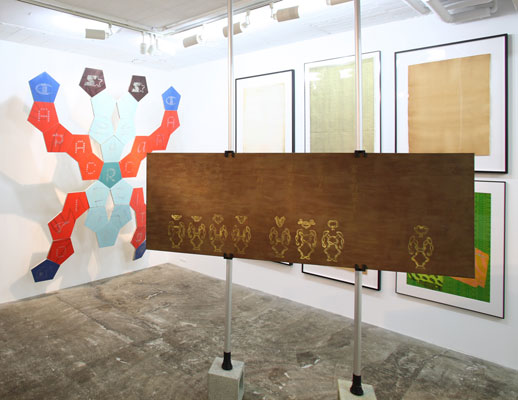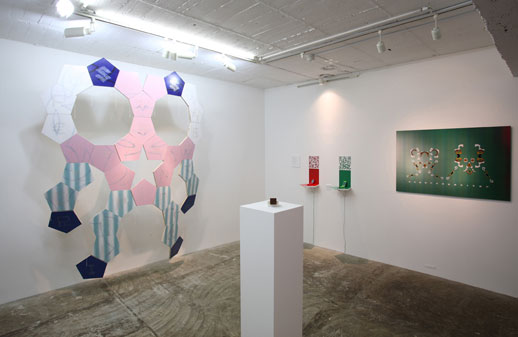Tadasu Takamine’s Supercapacitor! Say it again!
Arataniurano is a pleasant, smallish gallery. When you walk in the door you can take in a whole exhibit with one turn of the head, and this is a nice way to read a show, in one viewing, before you step to examine the pieces one by one.

Currently, the show is Tadasu Takamine’s “The Supercapacitor”. The pieces are quite varied, and expertly rendered. There is a rug, for example, and a set of textured silk screen prints (some made with mayonnaise), funny little electronic figures that you can download for free onto your mobile phone, a stamp made out of plaster and chocolate, large plywood hexagons connected in rings and painted in pastels, and even T-shirts. For all their variety, all the pieces are, in one way or another, branded with the word SUPERCAPACITOR (in English or katakana), or with the cute little characters (half monkeys half aliens) that I suppose are inspired by the physical structure of a supercapacitor. And, significantly, all the works are attractive.
In the center of the room, placed at an angle, is a large rectangular panel encrusted with brown oil paint. Carved into the paint is a line of those little characters and a haiku-like text. Clearly this huge tablet is the Rosetta Stone of the show, I thought to myself. The text reads:
Supercapacitor: Houses and vegetables and electricity.
We can make them ourselves.
So why are supercapacitors so expensive?
家も野菜も電力も
買わず自分で作れたら
スーパーキャパシタなぜ高い?

Something unsettling was happening. The theme of supercapacitors was both dominant and diminutive. A print-out, titled “About Supercapacitors” was being given by gallery staff. It explains that a supercapacitor is a device capable of storing energy with very little impact on natural resources, and is a highly viable solution to the world’s energy problems. It ends with this strangely flat statement of purpose: “If the technology is right there before our eyes, but the only thing preventing it from taking off is the high price, then I believe we have to find a way to remove that obstacle.”
The paper is unsigned (though it credits Cooperation: Takahito Hirano). I can only assume it was written by the artist. And yet in it, somehow, the artist is strangely absent. And, even more upsetting, the activist who authored the text (both the paper “About Supercapacitors” and the uncanny haiku on the huge tablet) is absent from the event, which remains firmly an apolitical art exhibition in a gallery.
I felt a lot of anxiety at this point, unable to bridge the gap between the actual work in front of me and the purpose clearly spelled out by the artist’s statement. Was my anxiety a measure of Takamine’s success?
In an interview with the artist, I asked him about his commitment to supercapacitors. Was he going to be fighting for this issue in 10 years? In 10 months? Takamine never answered this directly, but he spoke about how important supercapacitors could be for our urgent environmental problems. Supercapacitors were worthwhile, he insisted.
When I asked if the structure or function of the supercapacitor was a model for the works he made, he laughed and told me that, actually, he didn’t have a deep understanding of how the supercapacitor works. His only concern was to create works that would capture the viewers’ attention. Then, they too could start talking about supercapacitors without real knowledge. They could wear his cute T-shirts which carry and spread the word SUPERCAPACITOR, or they could download the funny little characters on their mobile phones and pass them to their friends.
This is supercapacitor as a buzz word, social progress initiated by armies of thoughtless but energetic repeaters. And perhaps this is art as a re-appropriation of advertisement, as a viral campaign — not for cigarettes or sneakers or even for the “next big artist” — but for sustainable energy. The Supercapacitor is not so much an exhibition, as it is a performance of an exhibition. And, standing in for the artist (who is the real product in the gallery and the art market), ladies and gentlemen, we introduce the supercapacitor.
Whether or not Takamine is successful in his project remains to be seen. But it is already some small measure of success that his work is so supported by Arataniurano, whose simple room can house awkward, complicated structures, mixed messages, and work that doesn’t fit comfortably into the assumptions and expectations of the art market.
Yelena Gluzman
Yelena Gluzman


